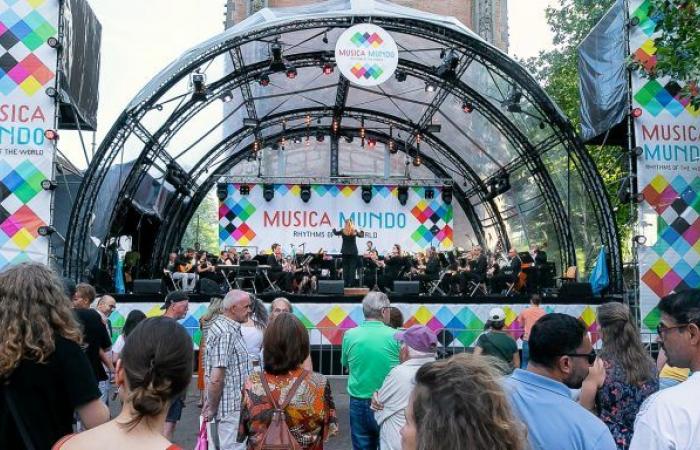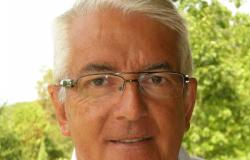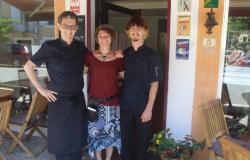During a festival intended to be eclectic and as colorful as organza, Amesfoort embraces the rhythms of the world with Musica Mundo. The day after the official ceremony of the seventh edition, from June 27 to 30, 2024, a parade with Gnaoua rhythms will crisscross the Dutch city, under the leadership of the Belgian-Moroccan group Remork & Karkaba. Setting the tone for an annual event that aims to be open to all sounds from here and elsewhere, the organizing foundation, ArteGanza, offered, on Thursday, an immersion in the spirit of artistic communion that it advocates, with the screening of two musical documentary films.
On the sidelines of this first day, the founder of the festival, Hassan Elammouri, declared to Yabiladi that “the purpose of music is to bring people together through the experience that the discovery of such different sounds allows. each other, but able to find their place in the same space. Surrounded by a solid network of volunteers and professionals, the initiator of ArteGanza capitalizes on the decompartmentalization of disciplines and artistic expressions in themselves, so as to “propose to see the world differently, through the glasses of what art can do.
Exploring the slavery past behind African music
As part of this program, the documentary “Tula Leeft” (Tula is alive) was shown to the public, in a process of exchange and reflection on the theme of slavery, addressed implicitly in the musical heritage that this collective experience has left within different nations. Co-directed by Izaline Calister and Thijs Borsten, this 45-minute film tells the story of Tula Rigaud, leader of the largest uprising against slavery on the island of Curaçao. It was screened after the artistic performance of Calister, Tula & Juliet.
Izaline Calister / Ph. Peter Putters – Musica Mundo Rythms of the World
“Tula Leeft” takes the form of a multidisciplinary sequel to this show with personal and collective inspiration. It begins with a decisive date: in 1795, the slaves of the “Kenepa” plantation rose up against the tutelage of their masters. Refusing to work under this regime then put in place by Holland, they released the prisoners and organized themselves to wrest their rights.
Driven by the conviction that everyone on Curaçao has the right to freedom and that slavery must be abolished, Tula led a movement that saw the mobilization of slaves from other surrounding plantations, but also from free communities. A few weeks later he was arrested and executed, which ended the uprising. The latter marked the beginning of the anti-slavery struggle in Curaçao, many years before its ban by law in the Netherlands. Since then, Tula has remained the symbol of resistance against domination. In 2010, he was elevated to the rank of national hero in Curaçao.
From a hand-sewn road movie, a historical and musical documentary at the same time, Izaline Calister reconstructs the elements of this multifaceted legacy. She celebrates a heritage that finds its echo in the collective memory of all the communities of African origin who stood up against slavery, all accompanied by the texts recounting this pain, but also the self-denial of these communities. “We followed in Tula’s footsteps in the literal sense, by going to the lands where the former slaves worked and the circuits of their march of uprising, until their assassination,” the singer told us, following the screening.
“As a singer and songwriter, I wanted to learn more about Curacao music. When we look at it, it leads us to the history of slavery because our music is strongly influenced by Africa and shaped in different ways, since our island has historically been a landmark for ships from everywhere. We have African influences, as well as Caribbean and Latin American ones, but the basic rhythms remain particularly those of Mali, Nigeria and Sierra Leone. I studied these musical colors because I believe that it is very important even for my music.”
Izaline Calister
Addressing the issue of the African roots of anti-slavery music and their interconnection, particularly in the case of Gnaoua in Morocco, Izaline Calister told Yabiladi that “this tells us, throughout history, that we can try to destroy populations, communities, but that through the artistic expression that music allows, people always find a way to give themselves strength, courage and determination to stick to their values, to overcome their collective pain and drama.” “In my opinion, music has served this purpose for several centuries. From Africa, several groups of people have been uprooted and taken somewhere else, but they have never forgotten who they are,” the artist added.
Ph. Peter Putters, Musica Mundo – Rhythms of the World
For Izaline Calister, “music also tells us this: looking more closely, we realize that each of these populations of African origin has taken their music with them. Then, depending on where she lived, she adapted these sounds to local or regional specificities. “This is why we find elements in common in all of this music, everywhere in the world. This is what gives people a power of resistance and a means of expression to tell their stories, as in a form of communion on a global scale,” she told us.
A musical journey through history, rhythm and harmony
In the second part of this screening session, the second documentary shown is “Nomads in Music”, the four-handed work of Thijs Borsten and Hassan Elammouri. Also in the form of a musical road movie, the film offers an immersion in the Saharan sounds of Morocco. The cultural programmer took Thijs there, to discover the group Tarwa’ N Tiniri, who also performed at Musica Mundo in 2022. As this journey progresses, it is an artistic questioning of the essence of music between rhythm and harmony which develops.
“Most of the musical programming here in Europe remains based on harmony,” notes Hassan Elammouri, who says he wants to offer other colors than the commonly accepted “retromania.” “It seemed important to me to create a space of diversity, where harmony has its place, but also rhythm,” the cultural actor told us, who advocates this mix in this documentary as well as in the festival initiated by the foundation he created himself.
“In this configuration, it must be said that Africa remains an artistic cradle and a base for several forms of music par excellence. It is taken as a reference by all those who work on rhythms, without forgetting of course other artistic strongholds rich in ancestral creation, such as India, Asia, Jamaica and Latin America in general.
Hassan Elammouri

For the initiator of Musica Mundo, “it is all the importance of opening up to this whole, particularly in times of political divisions, in order to create a dialogue so that we can be close or in phase with music, and therefore cultures, even if they do not seem to us to be ours in the first place. In this same spirit, diversity as a richness as great as the world is celebrated in Amersfoort throughout this festival, as evidenced by the daily program of concerts.








